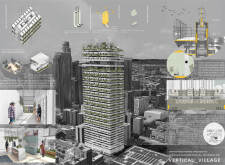5 key facts about this project
The Vertical Village project is a thoughtful response to the challenges found in urban living, particularly in Los Angeles. It is designed as a hub for both housing and community engagement, focusing on sustainability and well-being. By using a modular approach, it provides flexible dwelling options while accommodating social interactions among residents. The emphasis on green spaces enhances the living environment, offering a connection to nature in a densely populated area.
Filtration and Natural Ventilation
A key feature of the design is its filtration and natural ventilation system, which addresses the problem of air quality in urban settings. The filter fabric façade is essential for capturing pollutants from the city’s atmosphere, helping to improve the air that residents breathe indoors. This clever use of materials not only prioritizes health but also aligns with a commitment to creating sustainable living spaces.
Daylight Strategy
The project also makes effective use of daylight. By carefully spacing and positioning the building elements, each unit can receive plenty of natural light. This focus on daylight lowers the need for artificial lighting, contributing to energy efficiency and comfort. Residents benefit from a bright and inviting atmosphere, enhancing their overall experience within their homes.
Energy Production and Adaptive Reuse
Integrating energy production into the design is another important aspect. Wind turbines are used to capture natural energy, and the project includes a system that converts physical activity into stored energy. Additionally, the design proposes the adaptive reuse of old parking structures, turning them into much-needed affordable housing. This approach effectively addresses the housing crisis in Los Angeles by making use of underused urban spaces.
The distinguishing feature is the filter fabric façade, which serves both a practical and aesthetic purpose. By filtering out pollutants, it plays a vital role in improving health for residents while contributing to the overall urban landscape. This thoughtful design detail reflects a deeper commitment to sustainability and to creating a better environment for city dwellers.


















































